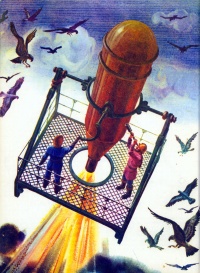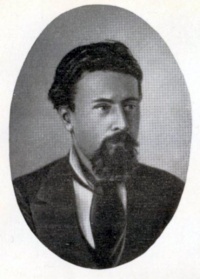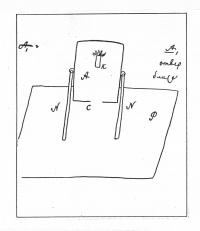Nicolai Kibalchich by Ron Miller
From The Space Library
Was Nikolai Kibalchich the first to suggest the idea of rocket-propelled space flight in 1881? Although there are earlier claimants to that accomplishment, most Russians would say “yes,” but whatever the answer, the story is tragic enough for a Russian novel and Kibalchich’s ideas certainly were ahead of their time.
Born into the family of a Ukrainian clergyman on October 19, 1853 he eventually entered the St. Petersburgh University of Railway Engineers in 1871, later transferring to the Medical Surgery Academy in 1873. Arrested in the autumn of 1875 for lending “revolutionary propaganda” to a peasant, Kibalchich spent almost 3 years in prison. During this time he read a great deal, added to his knowledge of English, French and German, and learned much from his talks fellow revolutionaries.
He went to prison as an inexperienced youth and emerged as a mature revolutionary who had sworn to devote all his time and energy to the Cause. He joined a revolutionary terrorist organization called the “People's Will.” He was given the job of chief technician of “Narodnaya Volya”: developer of projectiles. On 17 March Kibalchich was arrested on March 17, 1881 for complicity in the assassination of Tsar Alexander II.
At the trial Kibalchich impressed the chairman of the court, who said that the young man displayed “a remarkable mind, unusual stamina, hellish energy and amazing calmness.” In his final plea Kibal-chich spoke of his country's destiny and of the services he wanted to render mankind as a scientist. But the court was unrelenting and Kibalchich was executed on April 3, 1881.
Even before his arrest, Kibalchich had been thinking about a rocket-propelled apparatus. Unfortunately, his revolutionary and terrorist activities were too much of a distraction. He had plenty of time in prison, however, where he worked out some of the details of his flying machine while awaiting his death sentence.
“I am writing this project in prison,” his notes read, “several days before my death. I believe in the feasibility of my idea and this faith supports me in my terrible situation. If learned specialists find my idea realistic I shall be happy to be able to render service to my country and mankind. I shall meet death calmly then, knowing that my idea will not perish with me.”
Kibalchich repeatedly asked that his ideas be submitted for consideration by scientists. But instead his project was buried in secret archives. The project itself was published only after the October Revolution. The seminal Russian space historian, Nicolai Rynin said “. . . Kibal¬chich's priority should be established in advancing the idea of the use of jet engines for flying, the idea which, it is true, has not been put to practice yet but which is basically correct and promises a great deal for the future, particularly if thinking of interplanetary flights. . . . The same idea was developed by Tsiolkovsky after Kibalchich.”
Yakov Perelman, an early pioneer in Russian rocketry and astronautics, said that “In the language of modern engineering Kibalchich's invention must be called not an aeroplane but a spaceship, for this apparatus could fly in the absolute void of interstellar space . . . it was, in fact, the first step in the history of space flight."
Kibalchich himself seemed to have never considered spaceflight. He thought of his invention as a means of flying through the air. “In my thought about an aeronautic machine,” he wrote, “I have concentrated mainly on this question: what force has to be applied in order to set such machine in motion? In my opinion it is slowly burning explosive substances that can provide such a force.” He was also aware of the fact that his machine needed a source of fuel that would provide continuous combustion: “In fact, the combustion of explosive substance results with a comparative rapidity in large quantity of gases possessing a huge energy at the instance of their formation. But can one use the energy of gases, formed by explosive ignition, to perform work of any duration? This is possible only if the huge energy of explosive combustion, rather than last instantaneously, will be generated during a more or less prolonged period of time.” Sad to say, Kibalchich was not the first to suggest that a vehicle could be propelled by rocket propulsion. The Spanish inventor Frederico Gomez Arias did so in 1872, as did the Englishmen Butler and Edwards in 1869. (Amazingly, the latter’s design was for a delta-winged rocket plane!) Nevertheless, Kibalchich’s rocket ship did have some unique features, most notably that of having its engine mounted in a gimbal so it could be swiveled in any direction for steering. This was not accomplished in reality until Robert Goddard launched the first gimbal-steered rocket in 1937. Even so, the method was so technologically complex that even the engineers of the giant German V2 rocket opted for using steering vanes in the exhaust. The first practical rocket using a gimbal-mounted motor---the American Viking sounding rocket---wasn’t flown until 1949, 68 years after Kibalchich was executed and his work buried.



